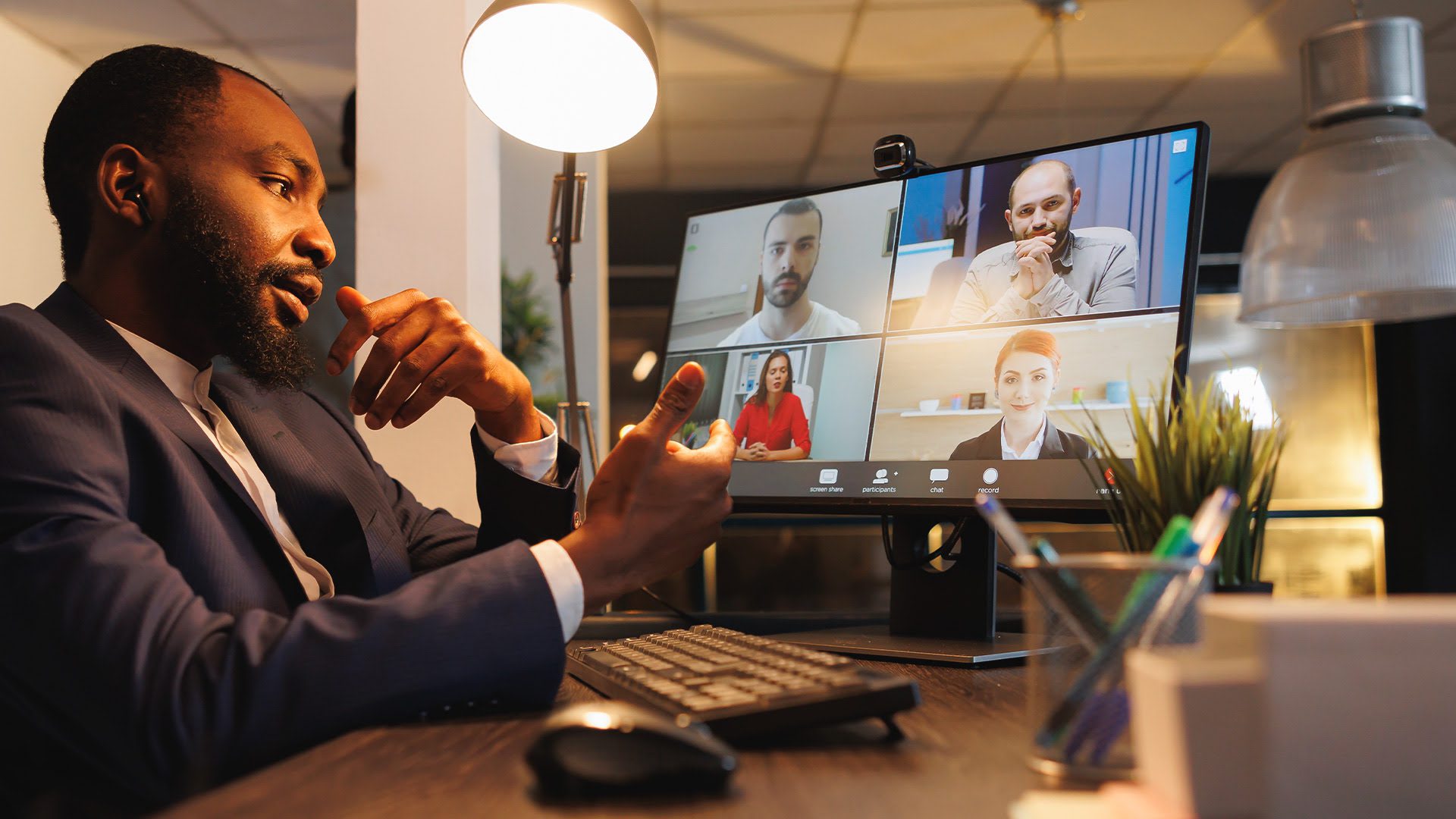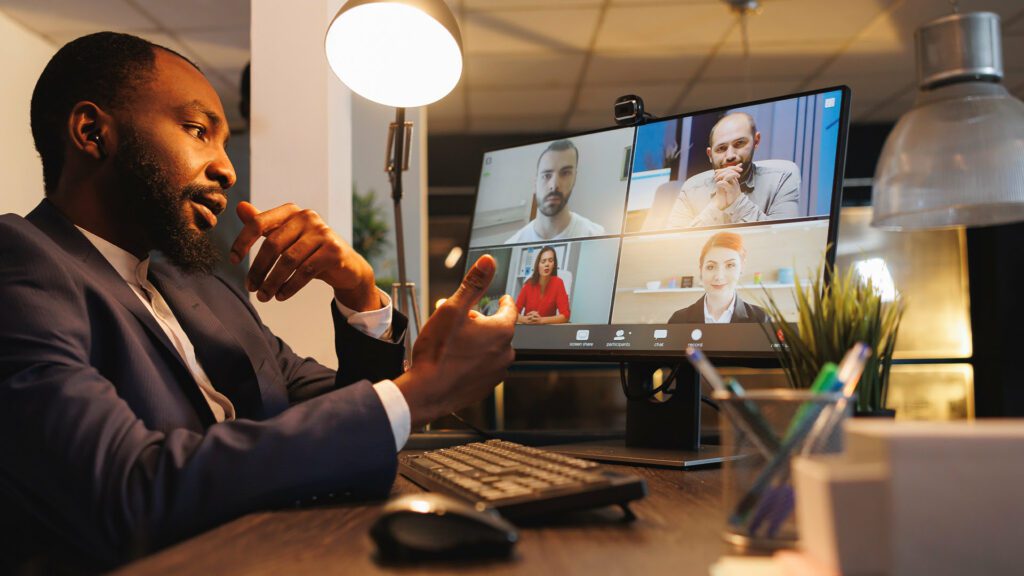Summary:
- The COVID-19 pandemic accelerated the adoption of video conferencing and digital solutions in courtrooms, revolutionizing judicial processes.
- Hybrid courtrooms are increasingly common in the legal system, presenting advantages and challenges to daily proceedings.
- Transitioning from traditional paper-based processes to digital workflows has significantly improved efficiency, security, and accessibility in the justice system.
- Advanced video conferencing tools will shape the future of courtroom technology.
- ET Group’s Justice Solutions provides innovative technology to enhance the courtroom, transforming traditional judicial processes for the modern era.
Transforming Courtrooms: Embracing the Hybrid Model

Cutting-edge technology is transforming courtrooms, revolutionizing the legal landscape, and making legal proceedings more efficient and accessible.
ET Group’s Justice Solutions are at the forefront of this transformation, helping courts across North America embrace hybrid models and digital workflows. In this blog, we explore the evolution of courtroom technology post-pandemic and how ET Group’s tools are enhancing the efficiency and flexibility of legal proceedings.
The Rise of Virtual Courtrooms Post-Pandemic
The COVID-19 pandemic has profoundly impacted many sectors, and the justice system is no exception. Traditional courtroom settings, relying on in-person attendance, faced significant challenges during lockdowns and social distancing measures. This situation accelerated the adoption of video conferencing systems in courtrooms, marking a pivotal shift towards digital and remote solutions.
Technology has been vital in changing how courtrooms operate. Some of these solutions are outlined below.
Video Conferencing Systems
The widespread use of video conferencing systems like MS Teams, Zoom, and Webex has allowed courts to continue operations remotely with virtual hearings, reducing the need for physical presence and maintaining judicial processes during the pandemic.
Mobile Video Carts
Mobile video carts are a flexible solution for supporting the new digital courtroom environment. They allow for easy setup and movement of video conferencing equipment, ensuring that virtual courtrooms can be established in various locations as needed, crucial for adapting to changing requirements brought about by the pandemic.
Virtual Courtroom Recording
Virtual courtroom recording is essential for modern courtrooms. It ensures accurate and comprehensive records of trials and hearings that are easily accessible for review and appeal. These recordings offer transparency and accountability by providing an unalterable record of what transpired during a session.
Assistive Listening Technology
Assistive listening technology, including hearing loops and wireless devices, helps individuals with hearing impairments fully engage in court proceedings. This ensures everyone can participate effectively and maintains fairness in the justice system.
Security and Privacy in Digital Courtrooms
The move to digital and hybrid courtrooms has many advantages, but it also raises concerns about digital security and the safety of participants. In traditional courtrooms, privacy and security are easier to maintain. In hybrid and virtual courtrooms, strict measures must be taken to protect sensitive information and ensure the safety of everyone involved. This involves implementing secure communication channels and comprehensive training for all users to reduce risks and uphold the integrity of the judicial process.
How Hybrid Courts are Becoming the New Normal

As the justice system adapts to a post-pandemic world, hybrid courtrooms have emerged as a promising model. Hybrid courtrooms combine in-person and remote participation, offering flexibility and efficiency. However, this model also presents several challenges that need to be addressed.
Here are some of the most significant benefits and challenges to hybrid courtrooms:
Benefits
A hybrid courtroom model easily accommodates participants who cannot attend court in person. This flexibility can lead to increased participation and reduced delays, enhancing the overall efficiency of the judicial process. Additionally, hybrid courtrooms can save costs by reducing the need for physical infrastructure and travel.
Challenges
Ensuring seamless integration between in-person and remote participants requires robust technological equipment and reliable internet connectivity. Managing a hybrid courtroom requires careful coordination to ensure all participants have equal access to information and can communicate effectively.
Digital vs. Paper: The Shift in the Justice System
The justice system has long relied on paper-based processes, where documents and evidence were physically handled and stored. This traditional approach, while familiar and tangible, comes with several drawbacks. However, virtual courtrooms offer several advantages. The shift from long-established methods to virtual workflows has been another significant change in the justice system.
Disadvantages of Traditional Paper-Based Courtrooms
Physical documents can easily be lost, damaged, or misplaced. Handling paper is time-consuming, and storing large volumes of documents requires significant physical space and resources. Additionally, the logistics of transporting documents between various parties can cause delays and inefficiencies.
How Virtual Courtrooms Have Made Positive Changes
The shift to digital workflows in the justice system brings improved sharing, tracking, and management of case files. Digital documents allow for quick retrieval and enhanced security through encrypted communication channels and secure storage, safeguarding confidential information.
Considering the Challenges of Change
Transitioning to digital workflows has clear benefits but comes with challenges. Ensuring everyone has the necessary technological skills and access to digital tools is important. Training, support, and strong cybersecurity measures are essential for adapting to new technologies and protecting sensitive information.
What the Future Looks Like for Legal Proceedings

Looking ahead, several trends are likely to shape the future of courtroom technology. Some of these include:
AI Automation
One of the most significant trends is the continued integration of artificial intelligence (AI) into the future judicial processes. AI could potentially help streamline administrative tasks, such as case management and document review, freeing up valuable time for judges and legal professionals.
Tailored Video Proceedings
Another emerging trend is using advanced video conferencing tools to enhance remote participation. These tools can provide high-quality audio and video features such as real-time translation and transcription, improving accessibility and communication for all participants.
Digital Evidence Presentation Systems
The development of more sophisticated digital evidence presentation systems is also likely to continue. These systems can offer interactive features, such as 3D modeling and virtual reality, providing a more immersive and detailed presentation of evidence.
Take the Next Step with ET Group’s Justice Solutions
ET Group’s Justice Solutions offer a range of innovative tools to transform judicial processes and enhance access to justice. Explore our solutions and see how we can help you navigate the challenges of hybrid courtrooms. Visit our website for more information and how our technology can make a difference in your courtroom.
Stay connected with us:
Follow ET Group on LinkedIn
Subscribe to ET Group’s YouTube Channel







